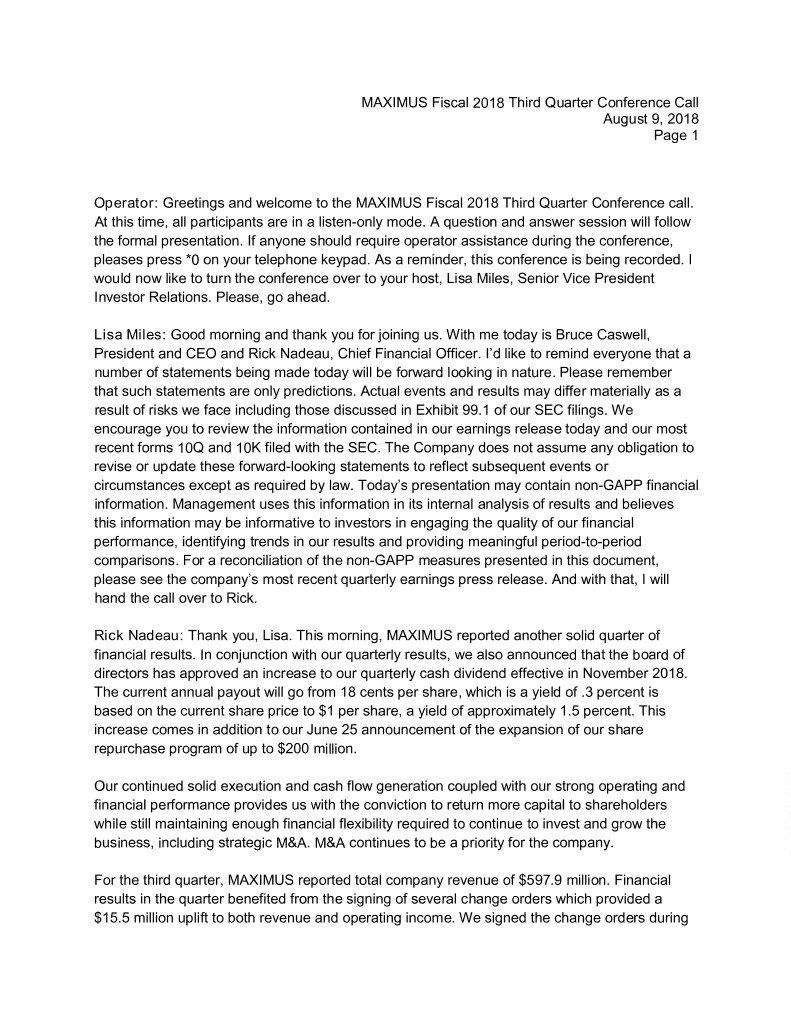
MAXIMUS Fiscal 2018 Third Quarter Conference Call August 9, 2018 Page 1 Operator: Greetings and welcome to the MAXIMUS Fiscal 2018 Third Quarter Conference call. At this time, all participants are in a listen-only mode. A question and answer session will follow the formal presentation. If anyone should require operator assistance during the conference, pleases press *0 on your telephone keypad. As a reminder, this conference is being recorded. I would now like to turn the conference over to your host, Lisa Miles, Senior Vice President Investor Relations. Please, go ahead. Lisa Miles: Good morning and thank you for joining us. With me today is Bruce Caswell, President and CEO and Rick Nadeau, Chief Financial Officer. I’d like to remind everyone that a number of statements being made today will be forward looking in nature. Please remember that such statements are only predictions. Actual events and results may differ materially as a result of risks we face including those discussed in Exhibit 99.1 of our SEC filings. We encourage you to review the information contained in our earnings release today and our most recent forms 10Q and 10K filed with the SEC. The Company does not assume any obligation to revise or update these forward-looking statements to reflect subsequent events or circumstances except as required by law. Today’s presentation may contain non-GAPP financial information. Management uses this information in its internal analysis of results and believes this information may be informative to investors in engaging the quality of our financial performance, identifying trends in our results and providing meaningful period-to-period comparisons. For a reconciliation of the non-GAPP measures presented in this document, please see the company’s most recent quarterly earnings press release. And with that, I will hand the call over to Rick. Rick Nadeau: Thank you, Lisa. This morning, MAXIMUS reported another solid quarter of financial results. In conjunction with our quarterly results, we also announced that the board of directors has approved an increase to our quarterly cash dividend effective in November 2018. The current annual payout will go from 18 cents per share, which is a yield of .3 percent is based on the current share price to $1 per share, a yield of approximately 1.5 percent. This increase comes in addition to our June 25 announcement of the expansion of our share repurchase program of up to $200 million. Our continued solid execution and cash flow generation coupled with our strong operating and financial performance provides us with the conviction to return more capital to shareholders while still maintaining enough financial flexibility required to continue to invest and grow the business, including strategic M&A. M&A continues to be a priority for the company. For the third quarter, MAXIMUS reported total company revenue of $597.9 million. Financial results in the quarter benefited from the signing of several change orders which provided a $15.5 million uplift to both revenue and operating income. We signed the change orders during

MAXIMUS Fiscal 2018 Third Quarter Conference Call August 9, 2018 Page 2 the third quarter, but the related costs were incurred in prior periods. This resulted in third quarter operating income of $8.26 million yielding an operating margin percentage of 13.8 percent in diluted earnings per share of 91 cents. The change order benefit was partially upset by certain large contracts in the health segment that were recently renewed and reset as well as by the ongoing startup of contracts in the human services segment. The operating margin of 12.7 percent for the nine months ended June 30, 2018 reflects a more normal margin profile. I will start my comments on segment results with the health services segment. Third quarter revenue for the health services segment increased 7 percent over the prior year, almost all of which was organic. This included favorable currency exchange translation of approximately 1 percent. Health services revenue and operating income benefited $13.7 million from the aforementioned change orders. As a result, operating margin for health services was 17.8 percent as compared to 15.4 percent in the prior year period. The segment is an operationally strong portfolio which can exceed 15 percent operating margins when circumstances are favorable. The uplift from the change orders was offset by forecasted changes on several sizeable contracts that were rebid, extended or the option periods were exercised such as the health assessment advisory service contract. The contracts have commenced service and are in the early cycles of program and margin maturity. As you might expect, operating margins in the fourth quarter for the health services segment will be at more normal levels and lower than Q3. This will also bring margins in line with the upper end of our targeted range of 10 to 15 percent, as some of these contracts will be in their early stages of maturity into fiscal 2019. As expected, third quarter revenue from the U.S. federal services segment decreased from the same period in the prior year. For the third quarter, operating margin was 13.3 percent. Segment operating margins benefited from higher volumes on a couple of performance-based contracts, including one of our assessments and appeals contracts. As we disclosed in our annual 10K filing each year, the federal segment does contain some state-based assessments and appeals work that is naturally more accretive. The heritage of our current assessments and appeals contracts across MAXIMUS started in the federal segment with our core Medicare appeals business and state Medicaid appeals work. These state-based assessments contracts within the federal portfolio are an extension of this Medicaid appeals work and we continue to manage it within this segment. We continue to expect that the U.S. federal segment will deliver margins in the 10 to 12 percent range. But investors can expect normal fluctuations driven by changes in the mix of contract type or changes in performance-based contracts. As expected, third quarter revenue for the
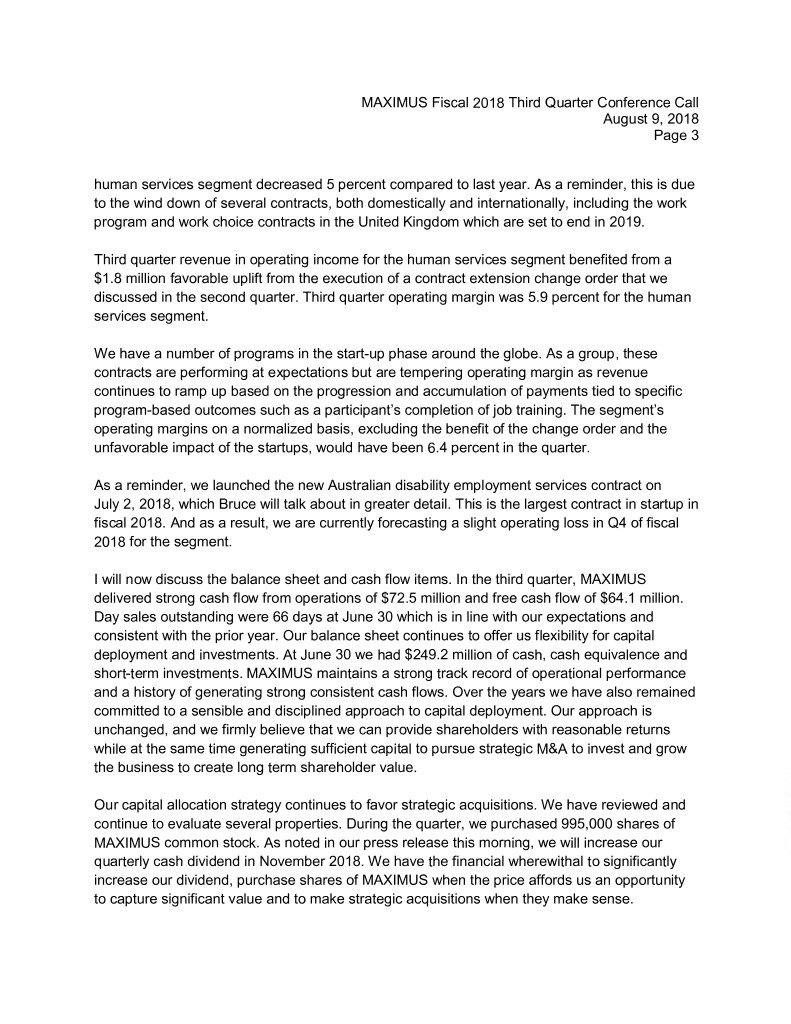
MAXIMUS Fiscal 2018 Third Quarter Conference Call August 9, 2018 Page 3 human services segment decreased 5 percent compared to last year. As a reminder, this is due to the wind down of several contracts, both domestically and internationally, including the work program and work choice contracts in the United Kingdom which are set to end in 2019. Third quarter revenue in operating income for the human services segment benefited from a $1.8 million favorable uplift from the execution of a contract extension change order that we discussed in the second quarter. Third quarter operating margin was 5.9 percent for the human services segment. We have a number of programs in the start-up phase around the globe. As a group, these contracts are performing at expectations but are tempering operating margin as revenue continues to ramp up based on the progression and accumulation of payments tied to specific program-based outcomes such as a participant’s completion of job training. The segment’s operating margins on a normalized basis, excluding the benefit of the change order and the unfavorable impact of the startups, would have been 6.4 percent in the quarter. As a reminder, we launched the new Australian disability employment services contract on July 2, 2018, which Bruce will talk about in greater detail. This is the largest contract in startup in fiscal 2018. And as a result, we are currently forecasting a slight operating loss in Q4 of fiscal 2018 for the segment. I will now discuss the balance sheet and cash flow items. In the third quarter, MAXIMUS delivered strong cash flow from operations of $72.5 million and free cash flow of $64.1 million. Day sales outstanding were 66 days at June 30 which is in line with our expectations and consistent with the prior year. Our balance sheet continues to offer us flexibility for capital deployment and investments. At June 30 we had $249.2 million of cash, cash equivalence and short-term investments. MAXIMUS maintains a strong track record of operational performance and a history of generating strong consistent cash flows. Over the years we have also remained committed to a sensible and disciplined approach to capital deployment. Our approach is unchanged, and we firmly believe that we can provide shareholders with reasonable returns while at the same time generating sufficient capital to pursue strategic M&A to invest and grow the business to create long term shareholder value. Our capital allocation strategy continues to favor strategic acquisitions. We have reviewed and continue to evaluate several properties. During the quarter, we purchased 995,000 shares of MAXIMUS common stock. As noted in our press release this morning, we will increase our quarterly cash dividend in November 2018. We have the financial wherewithal to significantly increase our dividend, purchase shares of MAXIMUS when the price affords us an opportunity to capture significant value and to make strategic acquisitions when they make sense.
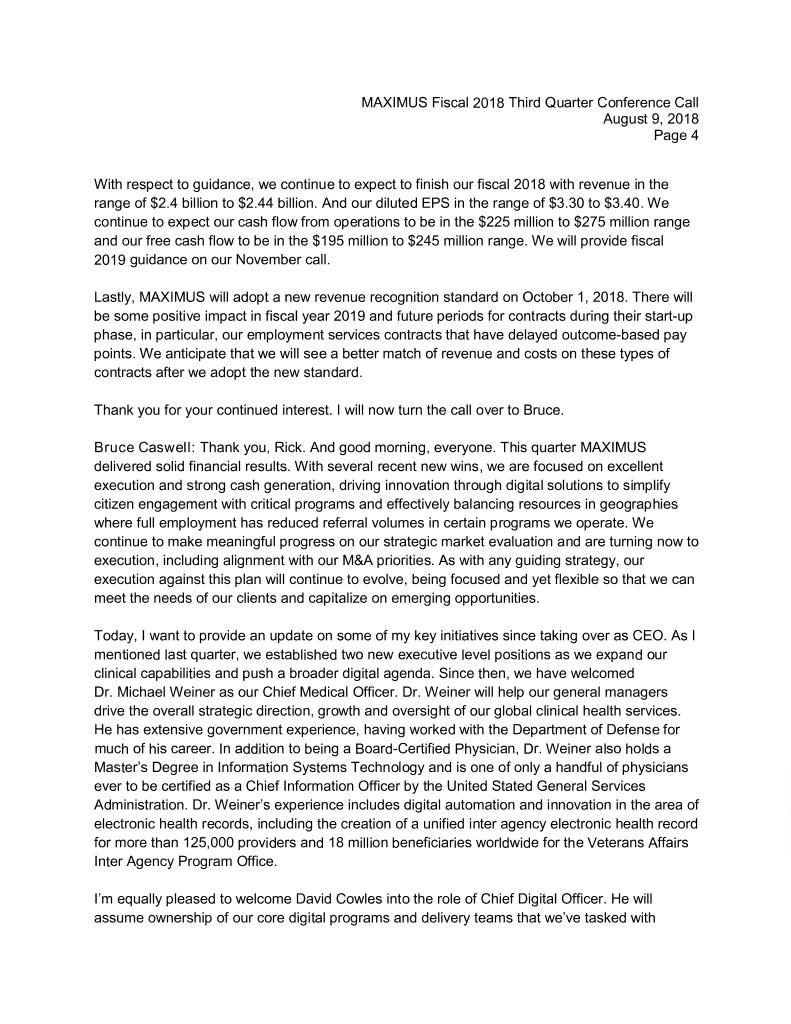
MAXIMUS Fiscal 2018 Third Quarter Conference Call August 9, 2018 Page 4 With respect to guidance, we continue to expect to finish our fiscal 2018 with revenue in the range of $2.4 billion to $2.44 billion. And our diluted EPS in the range of $3.30 to $3.40. We continue to expect our cash flow from operations to be in the $225 million to $275 million range and our free cash flow to be in the $195 million to $245 million range. We will provide fiscal 2019 guidance on our November call. Lastly, MAXIMUS will adopt a new revenue recognition standard on October 1, 2018. There will be some positive impact in fiscal year 2019 and future periods for contracts during their start-up phase, in particular, our employment services contracts that have delayed outcome-based pay points. We anticipate that we will see a better match of revenue and costs on these types of contracts after we adopt the new standard. Thank you for your continued interest. I will now turn the call over to Bruce. Bruce Caswell: Thank you, Rick. And good morning, everyone. This quarter MAXIMUS delivered solid financial results. With several recent new wins, we are focused on excellent execution and strong cash generation, driving innovation through digital solutions to simplify citizen engagement with critical programs and effectively balancing resources in geographies where full employment has reduced referral volumes in certain programs we operate. We continue to make meaningful progress on our strategic market evaluation and are turning now to execution, including alignment with our M&A priorities. As with any guiding strategy, our execution against this plan will continue to evolve, being focused and yet flexible so that we can meet the needs of our clients and capitalize on emerging opportunities. Today, I want to provide an update on some of my key initiatives since taking over as CEO. As I mentioned last quarter, we established two new executive level positions as we expand our clinical capabilities and push a broader digital agenda. Since then, we have welcomed Dr. Michael Weiner as our Chief Medical Officer. Dr. Weiner will help our general managers drive the overall strategic direction, growth and oversight of our global clinical health services. He has extensive government experience, having worked with the Department of Defense for much of his career. In addition to being a Board-Certified Physician, Dr. Weiner also holds a Master’s Degree in Information Systems Technology and is one of only a handful of physicians ever to be certified as a Chief Information Officer by the United Stated General Services Administration. Dr. Weiner’s experience includes digital automation and innovation in the area of electronic health records, including the creation of a unified inter agency electronic health record for more than 125,000 providers and 18 million beneficiaries worldwide for the Veterans Affairs Inter Agency Program Office. I’m equally pleased to welcome David Cowles into the role of Chief Digital Officer. He will assume ownership of our core digital programs and delivery teams that we’ve tasked with

MAXIMUS Fiscal 2018 Third Quarter Conference Call August 9, 2018 Page 5 building new capabilities that align with the strategic needs of the organization and our government clients. With nearly 30 years of operations management experience and a strong background in healthcare, David has a proven track record of driving innovation in data analytics, automation and digital transformation. David comes to MAXIMUS after spending much of his career in a variety of leadership roles at technology and consulting firms. We continue to increase our digital footprint as we drive innovation by piloting new mobile solutions to improve work flow and reduce paper-based documentation. Virtual agents to streamline the online user experience and increase the use of robotic process automation to manage certain business processes with greater efficiency. The MAXIMUS digital team is already making great strides in helping our government clients embrace digital technologies and modernize their programs. The team just wrapped up its second year supporting Medicaid recipients in Louisiana during the 2018 open enrollment period. As part of our core Medicaid offering, we provide Louisiana with a variety of digital support channels. You may recall that MAXIMUS designed and implemented the state’s mobile application for The Healthy Louisiana Medicaid program to help streamline, simplify and improve the customer enrollment journey. For the 2018 open enrollment period, digital enrollment volume, including both web and mobile doubled over last year. The greatest year-over-year increase occurred using The Healthy Louisiana mobile app where Medicaid enrollment volume tripled over last year. The Healthy Louisiana app is also gaining positive feedback from users with a 4.6 rating in both the app and Google Play stores. These ratings speak to three themes--the convenience, simplicity and speed by which a beneficiary can complete their Medicaid enrollment. This demonstrates how we can help states improve the accessibility and usability of programs by having a keen understanding of the complex needs and circumstances of the populations we serve. July was a busy month for our teams around the globe. On July 2, the new Australian Disability Employment Services or DES contract launched successfully. Under the new contract, MAXIMUS remains one of the largest employment services providers to the Government of Australia. Delivering the DES program across 197 sites to approximately 20,000 customers with disabilities. The contract represents a significant shift in the Australian disability sector with the Government’s introduction of a consumer choice model. In response, we introduced an innovative service delivery model that encompasses a greater digital platform as part of our overall solution. This includes new digital engagement for attracting and onboarding new customers, regular digital interaction with customers throughout their journey towards employment, including celebrating success and providing incentives and the ability to provide regular feedback on the services they receive. Ultimately, the data insights we gain from our end users digital activity deepens our understanding of their needs and gives us the ability to further improve our business processes.
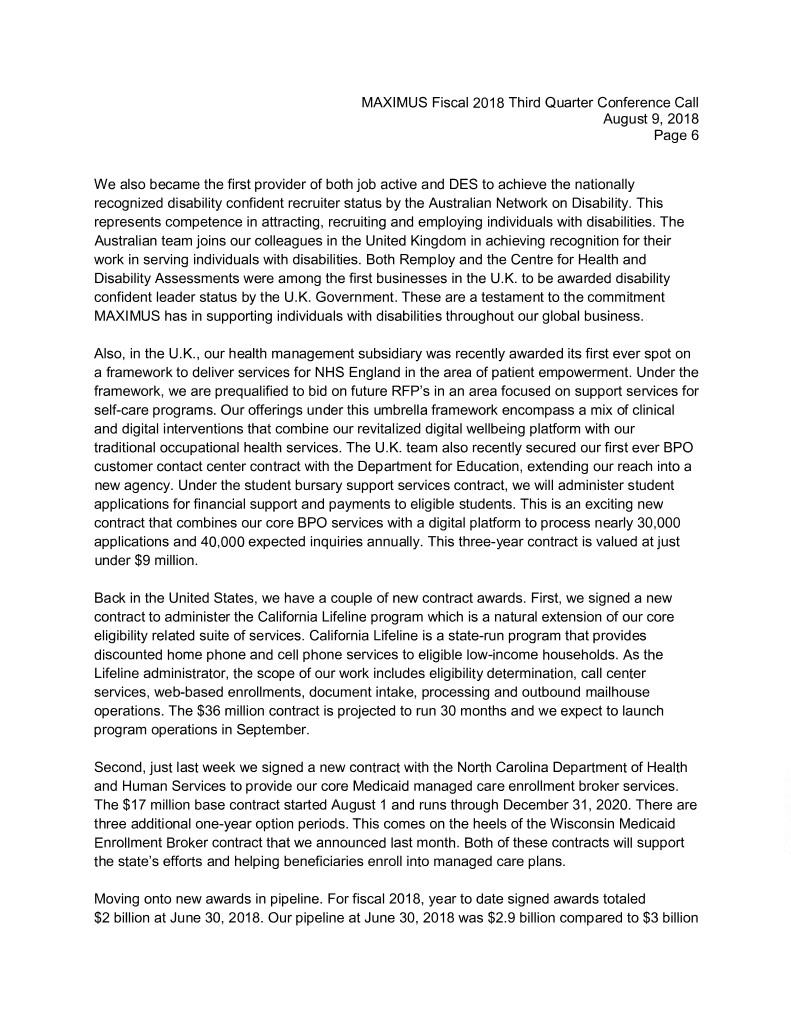
MAXIMUS Fiscal 2018 Third Quarter Conference Call August 9, 2018 Page 6 We also became the first provider of both job active and DES to achieve the nationally recognized disability confident recruiter status by the Australian Network on Disability. This represents competence in attracting, recruiting and employing individuals with disabilities. The Australian team joins our colleagues in the United Kingdom in achieving recognition for their work in serving individuals with disabilities. Both Remploy and the Centre for Health and Disability Assessments were among the first businesses in the U.K. to be awarded disability confident leader status by the U.K. Government. These are a testament to the commitment MAXIMUS has in supporting individuals with disabilities throughout our global business. Also, in the U.K., our health management subsidiary was recently awarded its first ever spot on a framework to deliver services for NHS England in the area of patient empowerment. Under the framework, we are prequalified to bid on future RFP’s in an area focused on support services for self-care programs. Our offerings under this umbrella framework encompass a mix of clinical and digital interventions that combine our revitalized digital wellbeing platform with our traditional occupational health services. The U.K. team also recently secured our first ever BPO customer contact center contract with the Department for Education, extending our reach into a new agency. Under the student bursary support services contract, we will administer student applications for financial support and payments to eligible students. This is an exciting new contract that combines our core BPO services with a digital platform to process nearly 30,000 applications and 40,000 expected inquiries annually. This three-year contract is valued at just under $9 million. Back in the United States, we have a couple of new contract awards. First, we signed a new contract to administer the California Lifeline program which is a natural extension of our core eligibility related suite of services. California Lifeline is a state-run program that provides discounted home phone and cell phone services to eligible low-income households. As the Lifeline administrator, the scope of our work includes eligibility determination, call center services, web-based enrollments, document intake, processing and outbound mailhouse operations. The $36 million contract is projected to run 30 months and we expect to launch program operations in September. Second, just last week we signed a new contract with the North Carolina Department of Health and Human Services to provide our core Medicaid managed care enrollment broker services. The $17 million base contract started August 1 and runs through December 31, 2020. There are three additional one-year option periods. This comes on the heels of the Wisconsin Medicaid Enrollment Broker contract that we announced last month. Both of these contracts will support the state’s efforts and helping beneficiaries enroll into managed care plans. Moving onto new awards in pipeline. For fiscal 2018, year to date signed awards totaled $2 billion at June 30, 2018. Our pipeline at June 30, 2018 was $2.9 billion compared to $3 billion
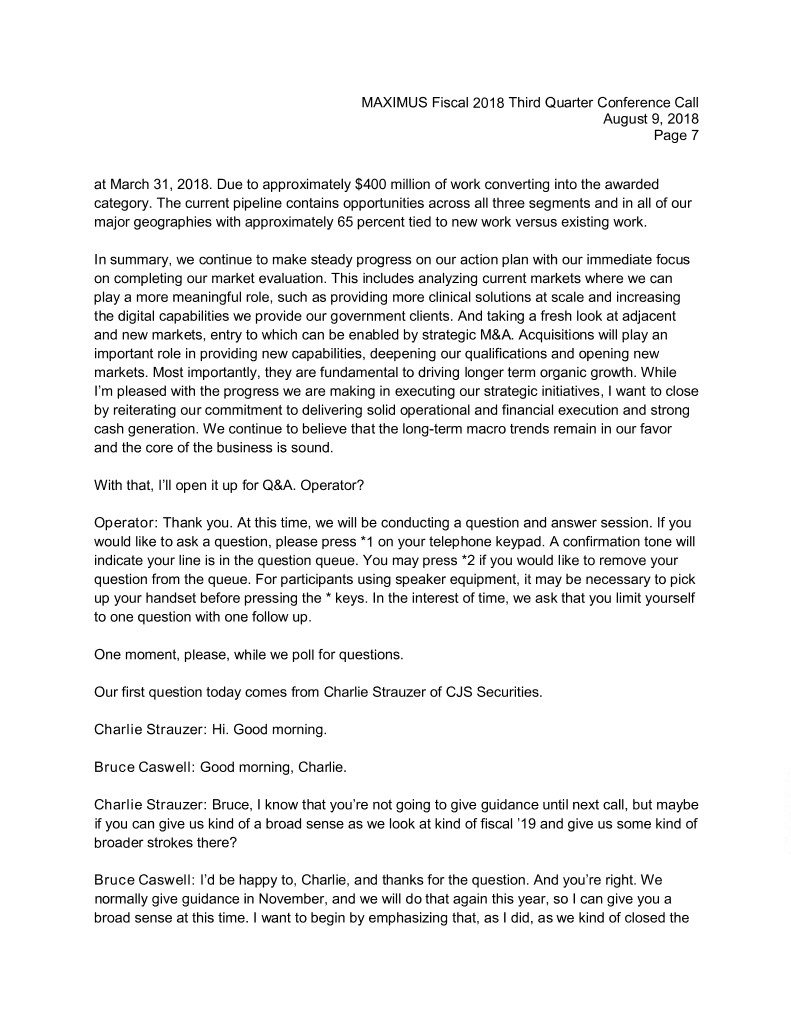
MAXIMUS Fiscal 2018 Third Quarter Conference Call August 9, 2018 Page 7 at March 31, 2018. Due to approximately $400 million of work converting into the awarded category. The current pipeline contains opportunities across all three segments and in all of our major geographies with approximately 65 percent tied to new work versus existing work. In summary, we continue to make steady progress on our action plan with our immediate focus on completing our market evaluation. This includes analyzing current markets where we can play a more meaningful role, such as providing more clinical solutions at scale and increasing the digital capabilities we provide our government clients. And taking a fresh look at adjacent and new markets, entry to which can be enabled by strategic M&A. Acquisitions will play an important role in providing new capabilities, deepening our qualifications and opening new markets. Most importantly, they are fundamental to driving longer term organic growth. While I’m pleased with the progress we are making in executing our strategic initiatives, I want to close by reiterating our commitment to delivering solid operational and financial execution and strong cash generation. We continue to believe that the long-term macro trends remain in our favor and the core of the business is sound. With that, I’ll open it up for Q&A. Operator? Operator: Thank you. At this time, we will be conducting a question and answer session. If you would like to ask a question, please press *1 on your telephone keypad. A confirmation tone will indicate your line is in the question queue. You may press *2 if you would like to remove your question from the queue. For participants using speaker equipment, it may be necessary to pick up your handset before pressing the * keys. In the interest of time, we ask that you limit yourself to one question with one follow up. One moment, please, while we poll for questions. Our first question today comes from Charlie Strauzer of CJS Securities. Charlie Strauzer: Hi. Good morning. Bruce Caswell: Good morning, Charlie. Charlie Strauzer: Bruce, I know that you’re not going to give guidance until next call, but maybe if you can give us kind of a broad sense as we look at kind of fiscal ’19 and give us some kind of broader strokes there? Bruce Caswell: I’d be happy to, Charlie, and thanks for the question. And you’re right. We normally give guidance in November, and we will do that again this year, so I can give you a broad sense at this time. I want to begin by emphasizing that, as I did, as we kind of closed the
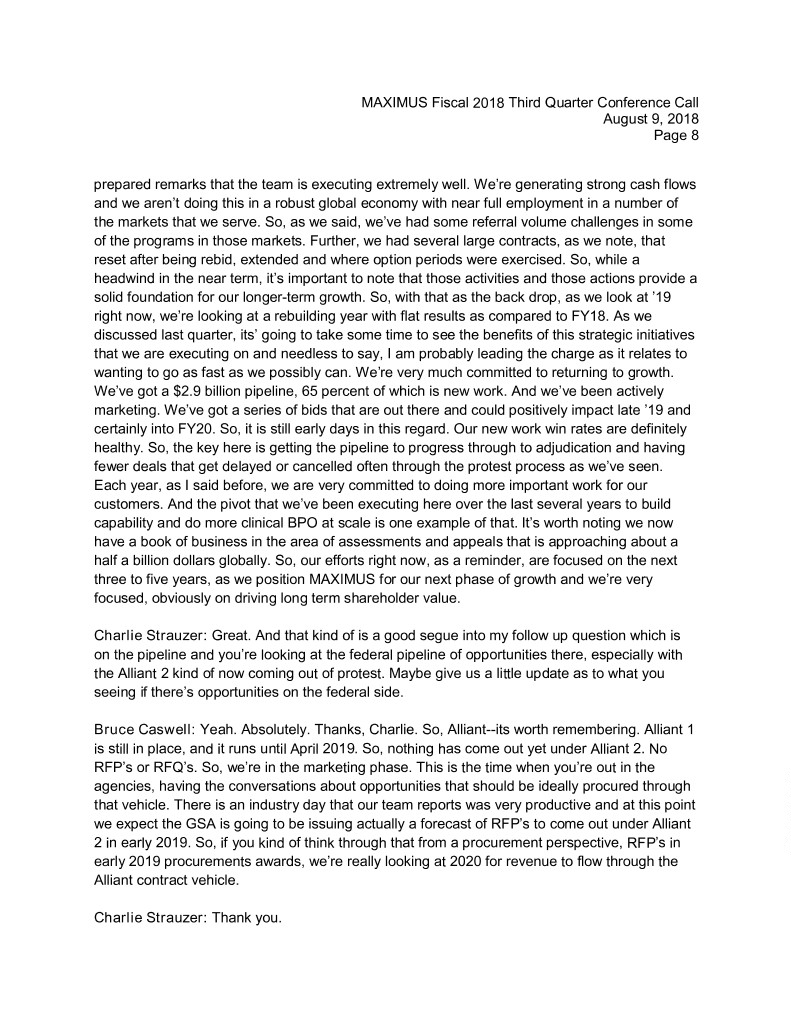
MAXIMUS Fiscal 2018 Third Quarter Conference Call August 9, 2018 Page 8 prepared remarks that the team is executing extremely well. We’re generating strong cash flows and we aren’t doing this in a robust global economy with near full employment in a number of the markets that we serve. So, as we said, we’ve had some referral volume challenges in some of the programs in those markets. Further, we had several large contracts, as we note, that reset after being rebid, extended and where option periods were exercised. So, while a headwind in the near term, it’s important to note that those activities and those actions provide a solid foundation for our longer-term growth. So, with that as the back drop, as we look at ’19 right now, we’re looking at a rebuilding year with flat results as compared to FY18. As we discussed last quarter, its’ going to take some time to see the benefits of this strategic initiatives that we are executing on and needless to say, I am probably leading the charge as it relates to wanting to go as fast as we possibly can. We’re very much committed to returning to growth. We’ve got a $2.9 billion pipeline, 65 percent of which is new work. And we’ve been actively marketing. We’ve got a series of bids that are out there and could positively impact late ’19 and certainly into FY20. So, it is still early days in this regard. Our new work win rates are definitely healthy. So, the key here is getting the pipeline to progress through to adjudication and having fewer deals that get delayed or cancelled often through the protest process as we’ve seen. Each year, as I said before, we are very committed to doing more important work for our customers. And the pivot that we’ve been executing here over the last several years to build capability and do more clinical BPO at scale is one example of that. It’s worth noting we now have a book of business in the area of assessments and appeals that is approaching about a half a billion dollars globally. So, our efforts right now, as a reminder, are focused on the next three to five years, as we position MAXIMUS for our next phase of growth and we’re very focused, obviously on driving long term shareholder value. Charlie Strauzer: Great. And that kind of is a good segue into my follow up question which is on the pipeline and you’re looking at the federal pipeline of opportunities there, especially with the Alliant 2 kind of now coming out of protest. Maybe give us a little update as to what you seeing if there’s opportunities on the federal side. Bruce Caswell: Yeah. Absolutely. Thanks, Charlie. So, Alliant--its worth remembering. Alliant 1 is still in place, and it runs until April 2019. So, nothing has come out yet under Alliant 2. No RFP’s or RFQ’s. So, we’re in the marketing phase. This is the time when you’re out in the agencies, having the conversations about opportunities that should be ideally procured through that vehicle. There is an industry day that our team reports was very productive and at this point we expect the GSA is going to be issuing actually a forecast of RFP’s to come out under Alliant 2 in early 2019. So, if you kind of think through that from a procurement perspective, RFP’s in early 2019 procurements awards, we’re really looking at 2020 for revenue to flow through the Alliant contract vehicle. Charlie Strauzer: Thank you.
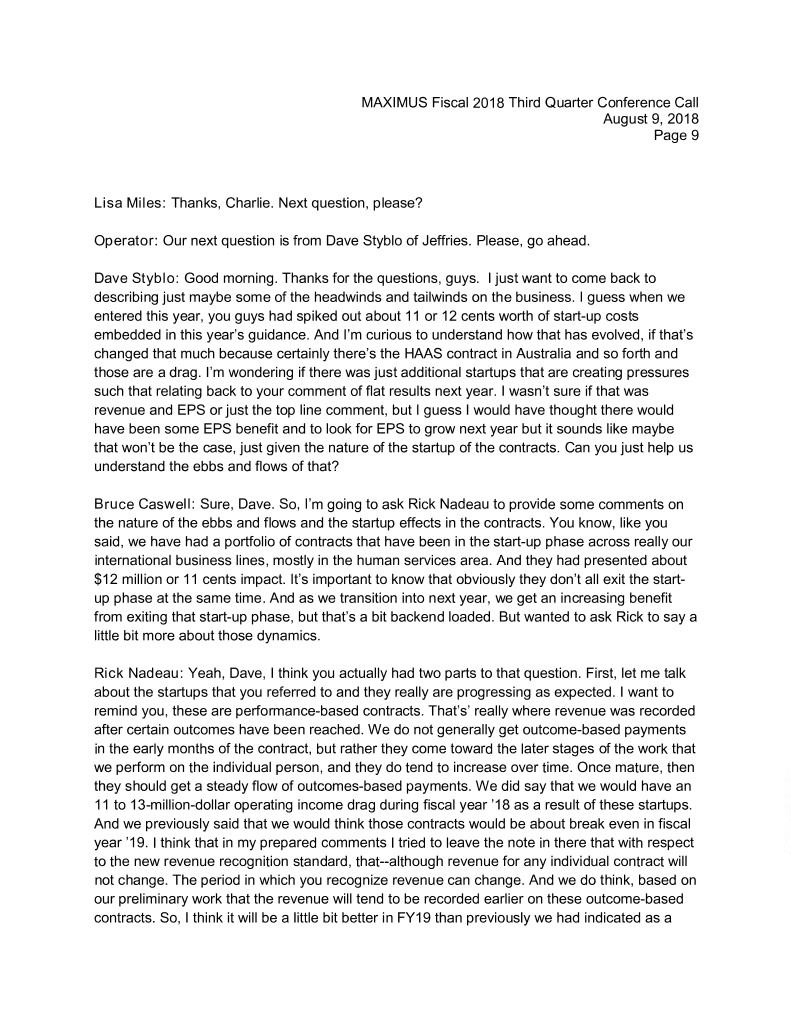
MAXIMUS Fiscal 2018 Third Quarter Conference Call August 9, 2018 Page 9 Lisa Miles: Thanks, Charlie. Next question, please? Operator: Our next question is from Dave Styblo of Jeffries. Please, go ahead. Dave Styblo: Good morning. Thanks for the questions, guys. I just want to come back to describing just maybe some of the headwinds and tailwinds on the business. I guess when we entered this year, you guys had spiked out about 11 or 12 cents worth of start-up costs embedded in this year’s guidance. And I’m curious to understand how that has evolved, if that’s changed that much because certainly there’s the HAAS contract in Australia and so forth and those are a drag. I’m wondering if there was just additional startups that are creating pressures such that relating back to your comment of flat results next year. I wasn’t sure if that was revenue and EPS or just the top line comment, but I guess I would have thought there would have been some EPS benefit and to look for EPS to grow next year but it sounds like maybe that won’t be the case, just given the nature of the startup of the contracts. Can you just help us understand the ebbs and flows of that? Bruce Caswell: Sure, Dave. So, I’m going to ask Rick Nadeau to provide some comments on the nature of the ebbs and flows and the startup effects in the contracts. You know, like you said, we have had a portfolio of contracts that have been in the start-up phase across really our international business lines, mostly in the human services area. And they had presented about $12 million or 11 cents impact. It’s important to know that obviously they don’t all exit the start- up phase at the same time. And as we transition into next year, we get an increasing benefit from exiting that start-up phase, but that’s a bit backend loaded. But wanted to ask Rick to say a little bit more about those dynamics. Rick Nadeau: Yeah, Dave, I think you actually had two parts to that question. First, let me talk about the startups that you referred to and they really are progressing as expected. I want to remind you, these are performance-based contracts. That’s’ really where revenue was recorded after certain outcomes have been reached. We do not generally get outcome-based payments in the early months of the contract, but rather they come toward the later stages of the work that we perform on the individual person, and they do tend to increase over time. Once mature, then they should get a steady flow of outcomes-based payments. We did say that we would have an 11 to 13-million-dollar operating income drag during fiscal year ’18 as a result of these startups. And we previously said that we would think those contracts would be about break even in fiscal year ’19. I think that in my prepared comments I tried to leave the note in there that with respect to the new revenue recognition standard, that--although revenue for any individual contract will not change. The period in which you recognize revenue can change. And we do think, based on our preliminary work that the revenue will tend to be recorded earlier on these outcome-based contracts. So, I think it will be a little bit better in FY19 than previously we had indicated as a
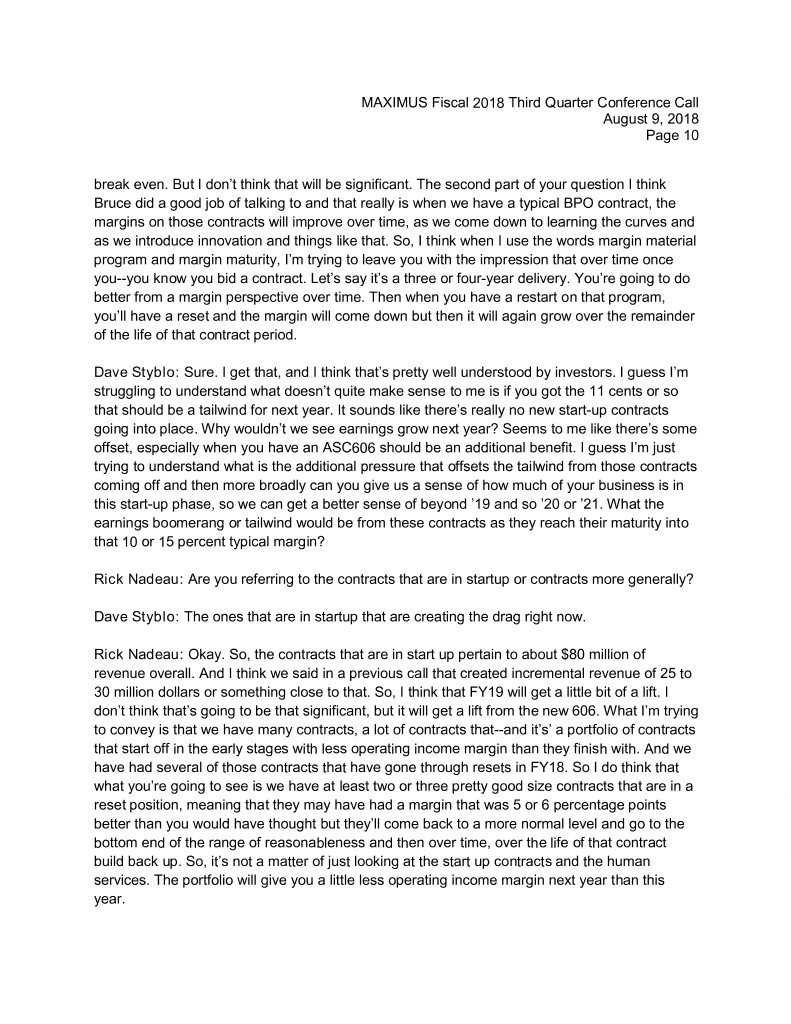
MAXIMUS Fiscal 2018 Third Quarter Conference Call August 9, 2018 Page 10 break even. But I don’t think that will be significant. The second part of your question I think Bruce did a good job of talking to and that really is when we have a typical BPO contract, the margins on those contracts will improve over time, as we come down to learning the curves and as we introduce innovation and things like that. So, I think when I use the words margin material program and margin maturity, I’m trying to leave you with the impression that over time once you--you know you bid a contract. Let’s say it’s a three or four-year delivery. You’re going to do better from a margin perspective over time. Then when you have a restart on that program, you’ll have a reset and the margin will come down but then it will again grow over the remainder of the life of that contract period. Dave Styblo: Sure. I get that, and I think that’s pretty well understood by investors. I guess I’m struggling to understand what doesn’t quite make sense to me is if you got the 11 cents or so that should be a tailwind for next year. It sounds like there’s really no new start-up contracts going into place. Why wouldn’t we see earnings grow next year? Seems to me like there’s some offset, especially when you have an ASC606 should be an additional benefit. I guess I’m just trying to understand what is the additional pressure that offsets the tailwind from those contracts coming off and then more broadly can you give us a sense of how much of your business is in this start-up phase, so we can get a better sense of beyond ’19 and so ’20 or ’21. What the earnings boomerang or tailwind would be from these contracts as they reach their maturity into that 10 or 15 percent typical margin? Rick Nadeau: Are you referring to the contracts that are in startup or contracts more generally? Dave Styblo: The ones that are in startup that are creating the drag right now. Rick Nadeau: Okay. So, the contracts that are in start up pertain to about $80 million of revenue overall. And I think we said in a previous call that created incremental revenue of 25 to 30 million dollars or something close to that. So, I think that FY19 will get a little bit of a lift. I don’t think that’s going to be that significant, but it will get a lift from the new 606. What I’m trying to convey is that we have many contracts, a lot of contracts that--and it’s’ a portfolio of contracts that start off in the early stages with less operating income margin than they finish with. And we have had several of those contracts that have gone through resets in FY18. So I do think that what you’re going to see is we have at least two or three pretty good size contracts that are in a reset position, meaning that they may have had a margin that was 5 or 6 percentage points better than you would have thought but they’ll come back to a more normal level and go to the bottom end of the range of reasonableness and then over time, over the life of that contract build back up. So, it’s not a matter of just looking at the start up contracts and the human services. The portfolio will give you a little less operating income margin next year than this year.
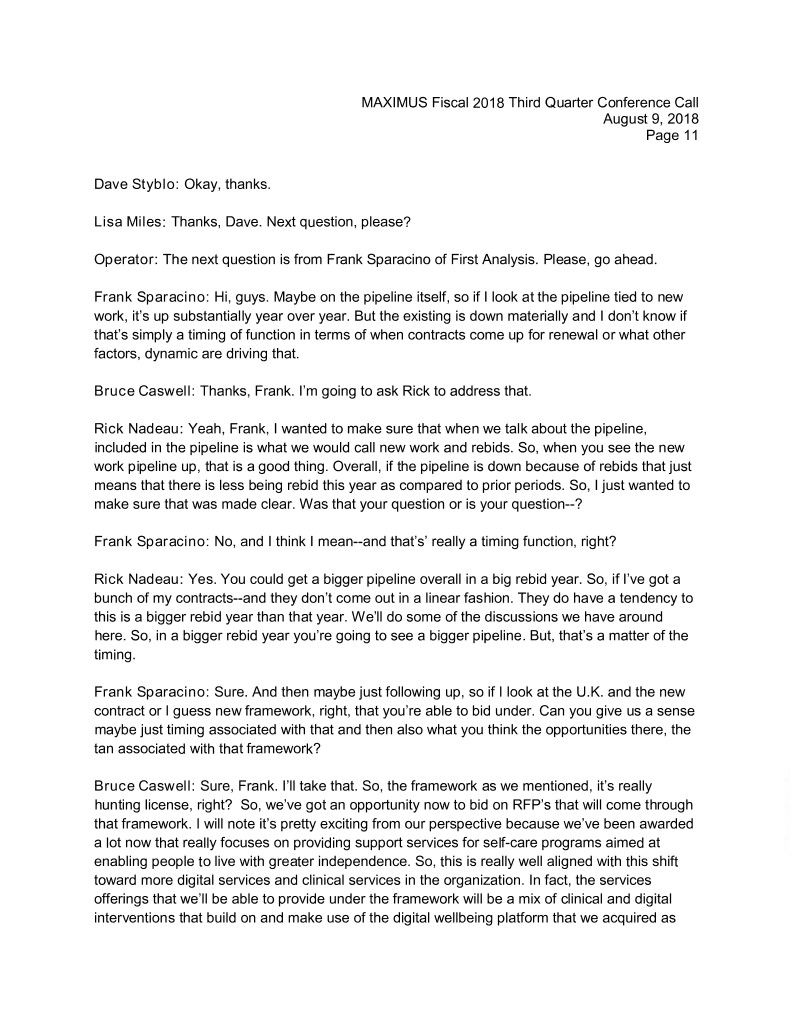
MAXIMUS Fiscal 2018 Third Quarter Conference Call August 9, 2018 Page 11 Dave Styblo: Okay, thanks. Lisa Miles: Thanks, Dave. Next question, please? Operator: The next question is from Frank Sparacino of First Analysis. Please, go ahead. Frank Sparacino: Hi, guys. Maybe on the pipeline itself, so if I look at the pipeline tied to new work, it’s up substantially year over year. But the existing is down materially and I don’t know if that’s simply a timing of function in terms of when contracts come up for renewal or what other factors, dynamic are driving that. Bruce Caswell: Thanks, Frank. I’m going to ask Rick to address that. Rick Nadeau: Yeah, Frank, I wanted to make sure that when we talk about the pipeline, included in the pipeline is what we would call new work and rebids. So, when you see the new work pipeline up, that is a good thing. Overall, if the pipeline is down because of rebids that just means that there is less being rebid this year as compared to prior periods. So, I just wanted to make sure that was made clear. Was that your question or is your question--? Frank Sparacino: No, and I think I mean--and that’s’ really a timing function, right? Rick Nadeau: Yes. You could get a bigger pipeline overall in a big rebid year. So, if I’ve got a bunch of my contracts--and they don’t come out in a linear fashion. They do have a tendency to this is a bigger rebid year than that year. We’ll do some of the discussions we have around here. So, in a bigger rebid year you’re going to see a bigger pipeline. But, that’s a matter of the timing. Frank Sparacino: Sure. And then maybe just following up, so if I look at the U.K. and the new contract or I guess new framework, right, that you’re able to bid under. Can you give us a sense maybe just timing associated with that and then also what you think the opportunities there, the tan associated with that framework? Bruce Caswell: Sure, Frank. I’ll take that. So, the framework as we mentioned, it’s really hunting license, right? So, we’ve got an opportunity now to bid on RFP’s that will come through that framework. I will note it’s pretty exciting from our perspective because we’ve been awarded a lot now that really focuses on providing support services for self-care programs aimed at enabling people to live with greater independence. So, this is really well aligned with this shift toward more digital services and clinical services in the organization. In fact, the services offerings that we’ll be able to provide under the framework will be a mix of clinical and digital interventions that build on and make use of the digital wellbeing platform that we acquired as
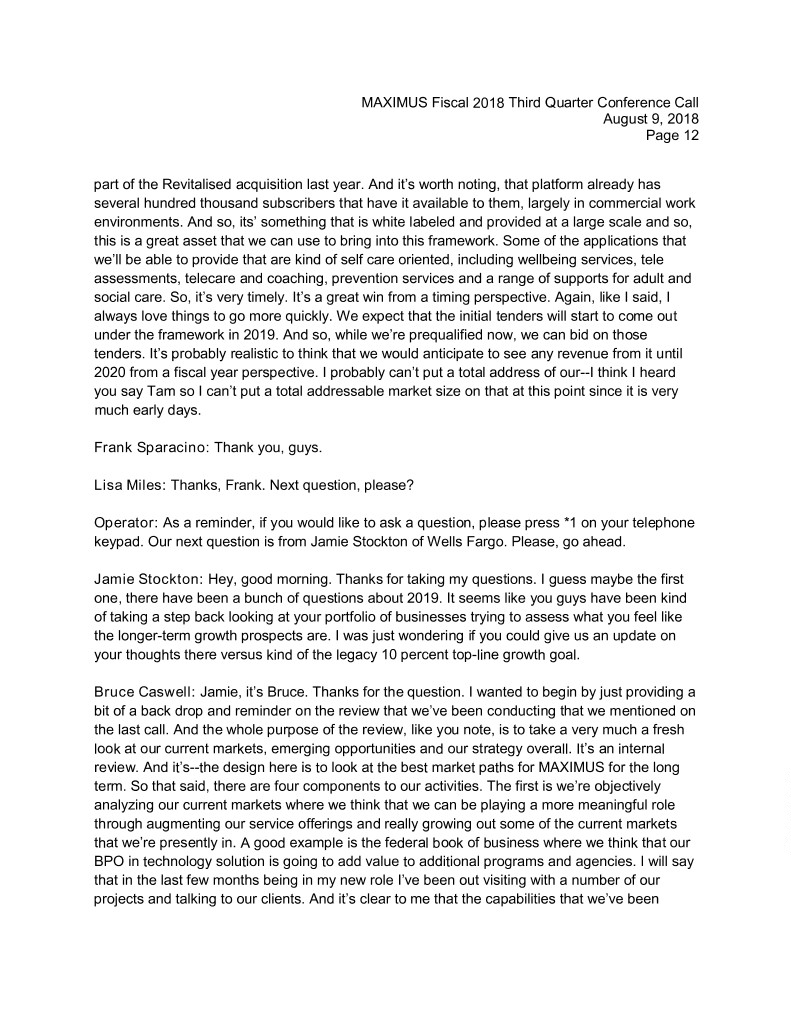
MAXIMUS Fiscal 2018 Third Quarter Conference Call August 9, 2018 Page 12 part of the Revitalised acquisition last year. And it’s worth noting, that platform already has several hundred thousand subscribers that have it available to them, largely in commercial work environments. And so, its’ something that is white labeled and provided at a large scale and so, this is a great asset that we can use to bring into this framework. Some of the applications that we’ll be able to provide that are kind of self care oriented, including wellbeing services, tele assessments, telecare and coaching, prevention services and a range of supports for adult and social care. So, it’s very timely. It’s a great win from a timing perspective. Again, like I said, I always love things to go more quickly. We expect that the initial tenders will start to come out under the framework in 2019. And so, while we’re prequalified now, we can bid on those tenders. It’s probably realistic to think that we would anticipate to see any revenue from it until 2020 from a fiscal year perspective. I probably can’t put a total address of our--I think I heard you say Tam so I can’t put a total addressable market size on that at this point since it is very much early days. Frank Sparacino: Thank you, guys. Lisa Miles: Thanks, Frank. Next question, please? Operator: As a reminder, if you would like to ask a question, please press *1 on your telephone keypad. Our next question is from Jamie Stockton of Wells Fargo. Please, go ahead. Jamie Stockton: Hey, good morning. Thanks for taking my questions. I guess maybe the first one, there have been a bunch of questions about 2019. It seems like you guys have been kind of taking a step back looking at your portfolio of businesses trying to assess what you feel like the longer-term growth prospects are. I was just wondering if you could give us an update on your thoughts there versus kind of the legacy 10 percent top-line growth goal. Bruce Caswell: Jamie, it’s Bruce. Thanks for the question. I wanted to begin by just providing a bit of a back drop and reminder on the review that we’ve been conducting that we mentioned on the last call. And the whole purpose of the review, like you note, is to take a very much a fresh look at our current markets, emerging opportunities and our strategy overall. It’s an internal review. And it’s--the design here is to look at the best market paths for MAXIMUS for the long term. So that said, there are four components to our activities. The first is we’re objectively analyzing our current markets where we think that we can be playing a more meaningful role through augmenting our service offerings and really growing out some of the current markets that we’re presently in. A good example is the federal book of business where we think that our BPO in technology solution is going to add value to additional programs and agencies. I will say that in the last few months being in my new role I’ve been out visiting with a number of our projects and talking to our clients. And it’s clear to me that the capabilities that we’ve been
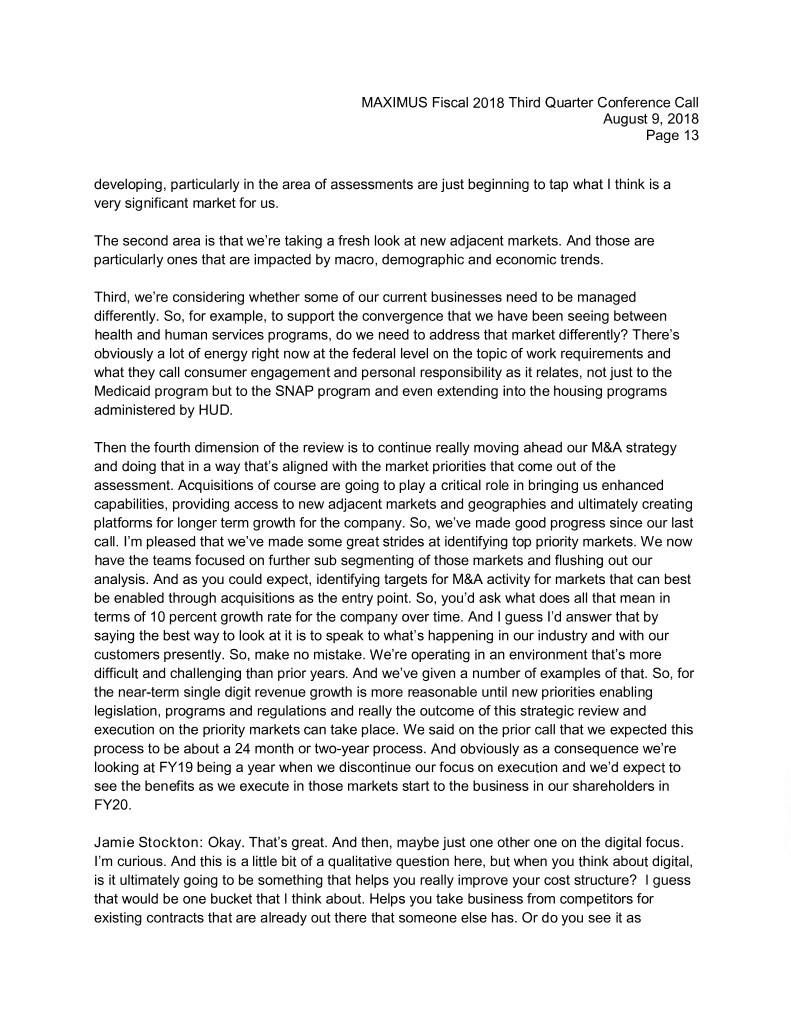
MAXIMUS Fiscal 2018 Third Quarter Conference Call August 9, 2018 Page 13 developing, particularly in the area of assessments are just beginning to tap what I think is a very significant market for us. The second area is that we’re taking a fresh look at new adjacent markets. And those are particularly ones that are impacted by macro, demographic and economic trends. Third, we’re considering whether some of our current businesses need to be managed differently. So, for example, to support the convergence that we have been seeing between health and human services programs, do we need to address that market differently? There’s obviously a lot of energy right now at the federal level on the topic of work requirements and what they call consumer engagement and personal responsibility as it relates, not just to the Medicaid program but to the SNAP program and even extending into the housing programs administered by HUD. Then the fourth dimension of the review is to continue really moving ahead our M&A strategy and doing that in a way that’s aligned with the market priorities that come out of the assessment. Acquisitions of course are going to play a critical role in bringing us enhanced capabilities, providing access to new adjacent markets and geographies and ultimately creating platforms for longer term growth for the company. So, we’ve made good progress since our last call. I’m pleased that we’ve made some great strides at identifying top priority markets. We now have the teams focused on further sub segmenting of those markets and flushing out our analysis. And as you could expect, identifying targets for M&A activity for markets that can best be enabled through acquisitions as the entry point. So, you’d ask what does all that mean in terms of 10 percent growth rate for the company over time. And I guess I’d answer that by saying the best way to look at it is to speak to what’s happening in our industry and with our customers presently. So, make no mistake. We’re operating in an environment that’s more difficult and challenging than prior years. And we’ve given a number of examples of that. So, for the near-term single digit revenue growth is more reasonable until new priorities enabling legislation, programs and regulations and really the outcome of this strategic review and execution on the priority markets can take place. We said on the prior call that we expected this process to be about a 24 month or two-year process. And obviously as a consequence we’re looking at FY19 being a year when we discontinue our focus on execution and we’d expect to see the benefits as we execute in those markets start to the business in our shareholders in FY20. Jamie Stockton: Okay. That’s great. And then, maybe just one other one on the digital focus. I’m curious. And this is a little bit of a qualitative question here, but when you think about digital, is it ultimately going to be something that helps you really improve your cost structure? I guess that would be one bucket that I think about. Helps you take business from competitors for existing contracts that are already out there that someone else has. Or do you see it as
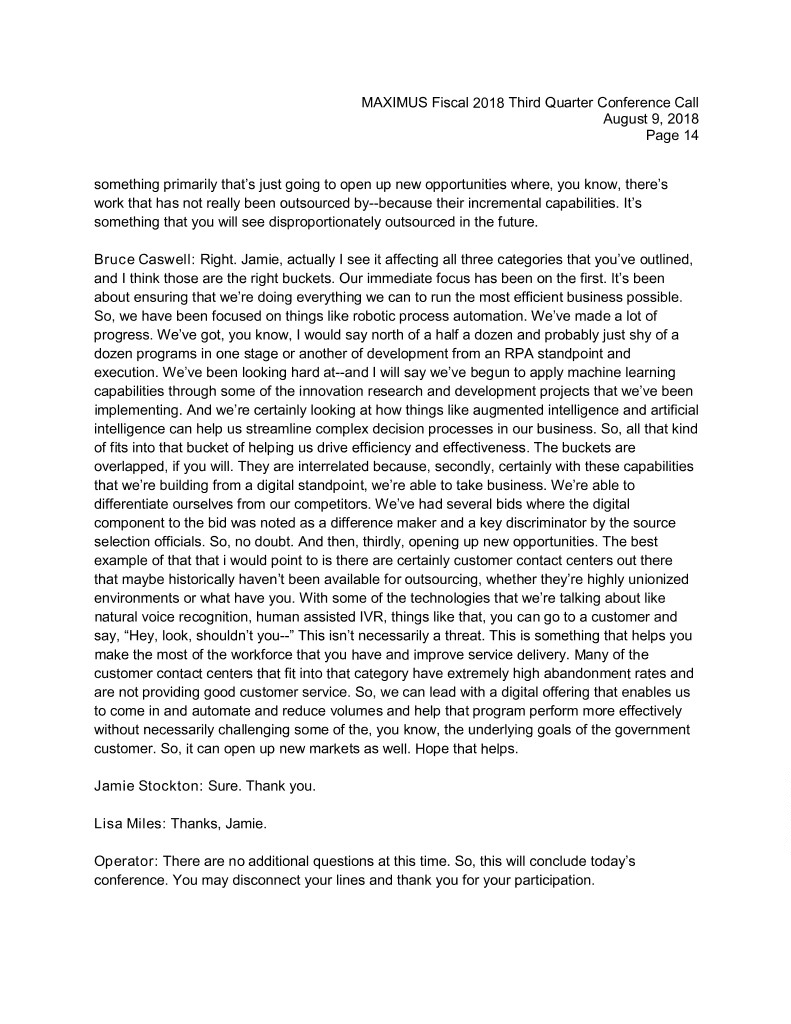
MAXIMUS Fiscal 2018 Third Quarter Conference Call August 9, 2018 Page 14 something primarily that’s just going to open up new opportunities where, you know, there’s work that has not really been outsourced by--because their incremental capabilities. It’s something that you will see disproportionately outsourced in the future. Bruce Caswell: Right. Jamie, actually I see it affecting all three categories that you’ve outlined, and I think those are the right buckets. Our immediate focus has been on the first. It’s been about ensuring that we’re doing everything we can to run the most efficient business possible. So, we have been focused on things like robotic process automation. We’ve made a lot of progress. We’ve got, you know, I would say north of a half a dozen and probably just shy of a dozen programs in one stage or another of development from an RPA standpoint and execution. We’ve been looking hard at--and I will say we’ve begun to apply machine learning capabilities through some of the innovation research and development projects that we’ve been implementing. And we’re certainly looking at how things like augmented intelligence and artificial intelligence can help us streamline complex decision processes in our business. So, all that kind of fits into that bucket of helping us drive efficiency and effectiveness. The buckets are overlapped, if you will. They are interrelated because, secondly, certainly with these capabilities that we’re building from a digital standpoint, we’re able to take business. We’re able to differentiate ourselves from our competitors. We’ve had several bids where the digital component to the bid was noted as a difference maker and a key discriminator by the source selection officials. So, no doubt. And then, thirdly, opening up new opportunities. The best example of that that i would point to is there are certainly customer contact centers out there that maybe historically haven’t been available for outsourcing, whether they’re highly unionized environments or what have you. With some of the technologies that we’re talking about like natural voice recognition, human assisted IVR, things like that, you can go to a customer and say, “Hey, look, shouldn’t you--” This isn’t necessarily a threat. This is something that helps you make the most of the workforce that you have and improve service delivery. Many of the customer contact centers that fit into that category have extremely high abandonment rates and are not providing good customer service. So, we can lead with a digital offering that enables us to come in and automate and reduce volumes and help that program perform more effectively without necessarily challenging some of the, you know, the underlying goals of the government customer. So, it can open up new markets as well. Hope that helps. Jamie Stockton: Sure. Thank you. Lisa Miles: Thanks, Jamie. Operator: There are no additional questions at this time. So, this will conclude today’s conference. You may disconnect your lines and thank you for your participation.